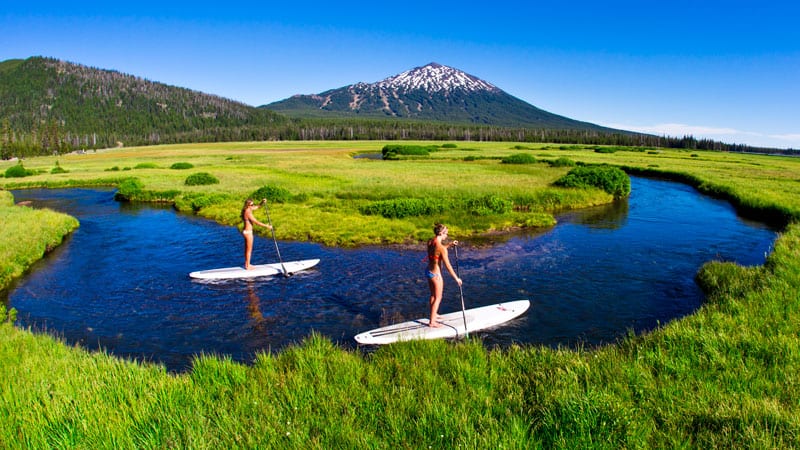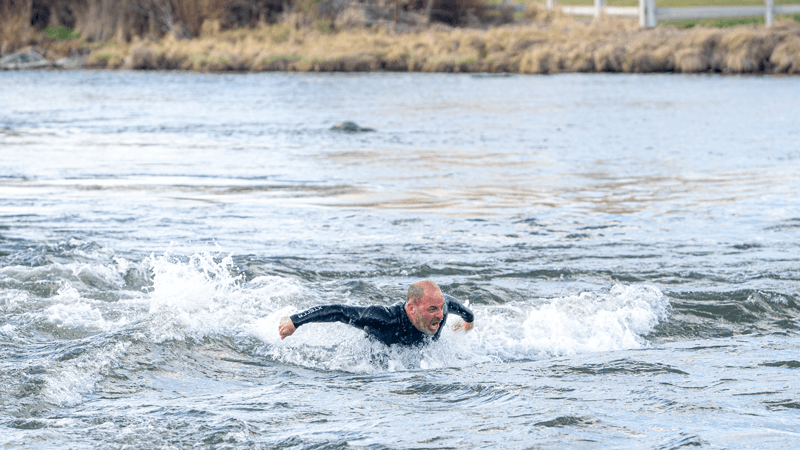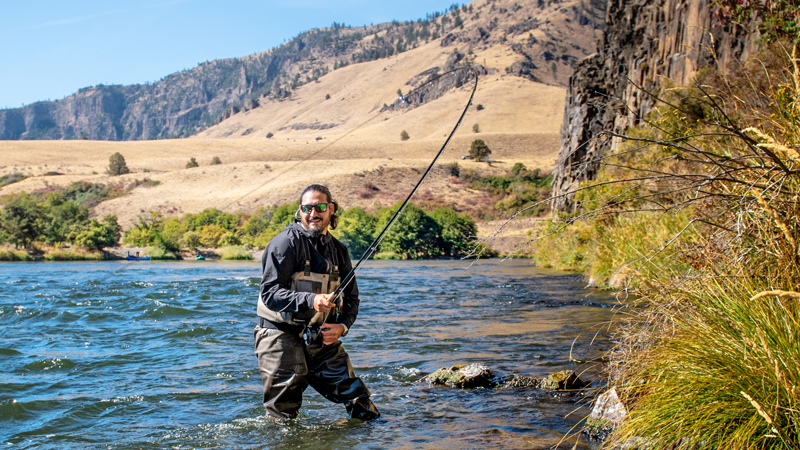A short walk from the forested parking lot to the put-in above Benham Falls on the upper Deschutes River. The kayakers, including Axel Hovorka, Orion Junkins, Ciaran Brown and Noah Metzler, hoist their kayaks on their shoulders, paddles in hand and walk cautiously along the icy path. They’re geared up in helmets, dry suits and minimalist PFDs that allow for the full range of motion required to paddle. They check their throw bags—a small bag filled with a nylon cord to be tossed to a boater in case of emergency—and clip on their whistles. The whistles are to be used to communicate on the river where the thundering sound of rushing water makes verbal communication impossible. The mission is serious, but the atmosphere among this group is anything but—the vibe is downright giddy. There’s a levity you might not expect when undertaking a serious section of Class V rapids, but this crew is confident, experienced and it’s clear that this sport is a lifestyle—one focused on fun and community.
As they make their way towards the put-in the boaters peer down over the cliffside at the quarter of a mile stretch of rapids looking for hazards such as fallen trees and share bits of beta as they go. They’ve all paddled this stretch innumerable times, but the river changes with the season as the amount of water flowing through it fluctuates. The flow of the Deschutes River isn’t a natural release tied to snowmelt and rainfall, instead it’s a manufactured season at the directive of Wickiup Reservoir. This time of year, the river is flowing at just under 500 CFS (cubic feet per second). The flows in this upper section of rapids, which also includes Dillon Falls and Lava Island Falls below, begin to increase as the dam opens in mid-April for irrigation. The flows ramp up gradually through the spring, peaking in the summer when they’re the rowdiest and most consequential, before settling back down in the fall and winter. The flow can range from 500 to 1,500 CFS, a metric that’s tracked and shared on websites bookmarked and monitored by these boaters, not just for the Deschutes, but for all of Oregon’s rivers and creeks.
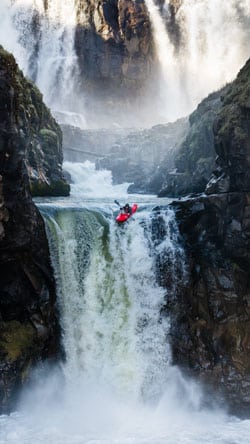
The kayak season is year-round here in Oregon. There are innumerable whitewater rivers within striking distance of Bend including the spring-fed Metolius River in Camp Sherman, the McKenzie, North Santiam and the Umpqua over the pass. Then there’s the Columbia River Gorge near Hood River, which has been referred to as the “Hollywood of whitewater boating,” thanks to the bounty of rapids, boulders and yes, massive waterfall drops most prolific on the Little White Salmon and numerous other creeks and offshoots draining into the Columbia River.
While this group of boaters is casual about running these rapids, this expert section of the Deschutes is definitely not where you want to get acquainted with the basics of whitewater kayaking. Running big water has a steep learning curve, boaters need to master the roll—a key move that allows a flipped boater to upright their boat with a hip jerk and a firm paddle stroke. This move is first achieved in calm water and then relearned in the rapids. A failure to upright the boat usually leads to a dangerous wet exit—basically the equivalent of a yard sale in skiing, except in kayaking the rushing water adds an element of swimming through an avalanche, and you must rely on your fellow boaters to retrieve your equipment downstream. A high-level of fitness is also needed to paddle hard to avoid being dragged back into a churning hole or up against a ledge. Finally, and an almost intimate understanding of river hydraulics gained through years of experience is crucial.
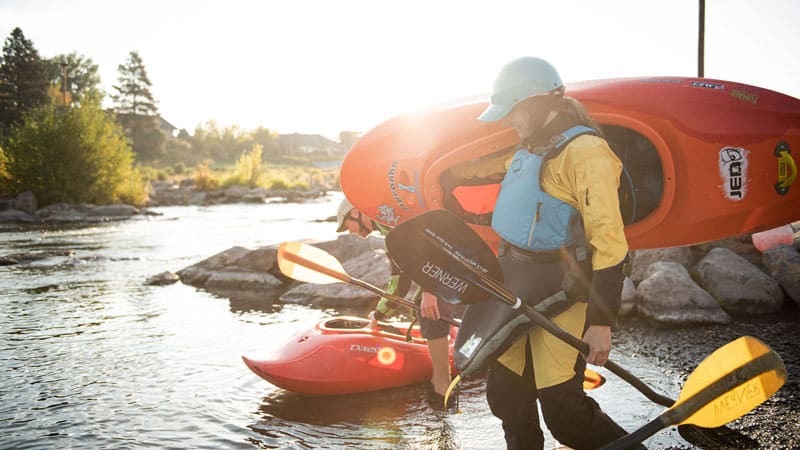
The experienced crew arrive at the put-in, a calm and unexpectedly quiet pool. They tuck into their boats, feet firmly pressed against the pegs for stability, with spray skirts sealing them into their creek boats. These boats, built specifically for navigating whitewater, are longer and more voluminous than the squat playboats you might see at the Whitewater Park in downtown Bend. Creek boats are built to be responsive, allowing the paddler to precisely navigate through the whitewater and stay on their line.
A few strong paddle strokes and a gentle hip tilt brings the boaters out of the eddy and into the main current of the river and they’re off. The first boater takes a line river right paddling into the green tongue and easily flowing through the upper section of the falls, he pulls over into a calm eddy, sounding his whistle to signal that it’s a go. The next boater finds a similar line, but he keeps his speed up as he passes by, dropping into a churning constriction and navigating expertly to exit into another quiet pool. Another sharp whistle blow signals for the rest of the crew to join him. The river below from here gets even more consequential, taking a sharp left turn narrowing between a ledge and an exposed boulder. This is clearly the crux of Benham Falls, the water is crashing into the exposed wall, churning over unseen rocks and boiling up from below. The boaters take turns positioning their boats through a rapid succession of paddle strokes, each finding their own paths through this section showcasing a thrilling display of the creativity inherent in the sport.
They regroup in a pool below the rapids and decide to lap it again, and then again. Each lap reveals new routes: Hovorka boofs off a boulder, up-top landing in the aerated water below, Ciaran flips over in the crux and then expertly uprights. They all play on a standing wave in the river, casually surfing back and forth. Back at the cars they strip off the layers of gear and talk about future plans—there’s a waterfall that Hovorka is eyeing on the Umpqua, a possible weekend pilgrimage to White Salmon—the options are endless for these Central Oregon paddlers.
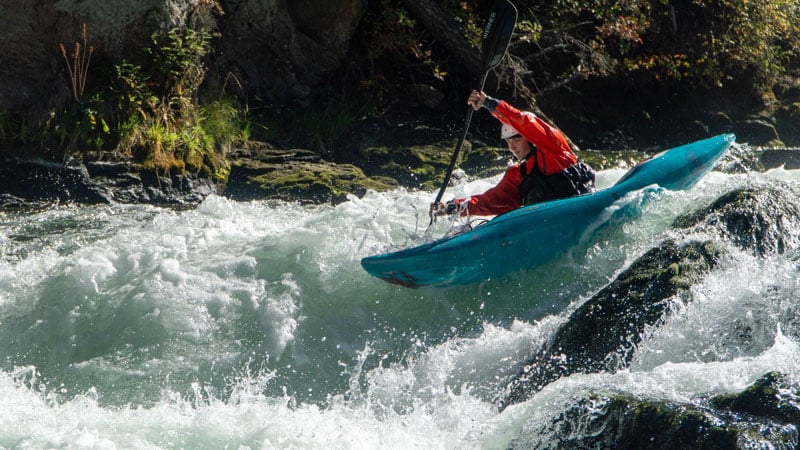
Getting Started
Tumalo Creek
Tumalo Creek offers a two-and-a-half-day Full Immersion Whitewater Kayaking Weekend. The course begins Friday evening on the shop’s back lawn and along a flatwater stretch of the Deschutes River, where you’ll learn essential safety techniques and boat fitting. The course then heads to Deschutes’ milder rapids and ends running a stretch of the McKenzie or other nearby Class II-III river. Participants can then layer on skills through the shop’s weekly Whitewater Skill Builder workshops throughout the summer. See tumalocreek.com.
Find a Crew
OSU Paddle Club
Whitewater kayaking is not a solo endeavor—you’ll need a crew. Central Oregon boaters can connect at the Whitewater Park, in the popular 3,000-member strong Bend Whitewater Facebook group, or through the OSU Paddle Club. See osucascades.edu.
Click to read more WATER SPORTS articles with us.




